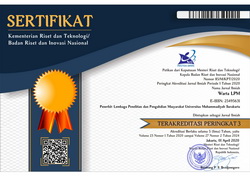Upaya Penurunan Prokrastinasi Akademik Siswa Melalui Pelatihan Time Management
DOI:
https://doi.org/10.23917/warta.v25i4.913Keywords:
academic procrastination, time management trainingAbstract
The transition period of the online learning process from home creates an imbalance in school life and creates conditions of academic delay or procrastination among students. Based on previous research on 345 students at SMP Negeri 2 Jatisrono in February 2022, the results of student academic procrastination at the school were quite high. This community service activity aims to reduce the high level of student academic procrastination through time management training. The training was attended by 31 students at SMP Negeri 2 Jatisrono. The instrument used to measure the level of student academic procrastination is the academic procrastination scale. Measurements were carried out 2 times, namely before (pre test) and after (post test) training to determine the effectiveness of time management training in reducing the level of academic procrastination experienced by students. The results of data analysis using T-test showed a score of t = 40.83 with p = 0.000 (p <0.05), which means that there is a very significant decrease in academic procrastination after receiving time management training. In conclusion, time management training is very significantly effective in reducing academic procrastination in students at SMP Negeri 2 Jatisrono. Suggestions for further research is that this kind of training can be applied to other problems because it is able to reduce forms of negative behavior so that it can optimize learning outcomes and student achievement.
Downloads
References
Afrashteh, Majid Yousefi, and Mohadeseh Koohneshin Seighalani. 2021. “Comparing The Effect of Virtual and Face-to-Face Education on Learning Motivation and Procrastination in Elementary School Students During the Coronavirus Pandemic (COVID-19).” 3(3):225–33.
Behzad, Rabiullah. 2021. “The Relationship between Smartphone Addiction and Procrastination.” Annals of the Romanian Society for Cell Biology 25(4):8316–23.
Fauziah, Hana Hanifah. 2016. “Fakor-Faktor Yang Mempengaruhi Prokrastinasi Akademik Pada Mahasiswa Fakultas Psikologi Uin Sunan Gunung Djati Bandung.” Psympathic?: Jurnal Ilmiah Psikologi 2(2):123–32. doi: 10.15575/psy.v2i2.453.
Gonda, Dalibor, Gabriela Pavlovi?, and Anna Tirp. 2021. “Setting Up a Flipped Classroom Design to Reduce Student Academic Procrastination.”
Drs, P. I., Kamil, H. B., Pd, M. I., Ii, P., Thahir, A., Psi, S., Ed, D., Tarbiyah, F., & Keguruan, D. A. N. (n.d.). Management Untuk Menurunkan Perilaku Prokrastinasi Skripsi Diajukan untuk Melengkapi Tugas-tugas dan Memenuhi Syarat-syarat Guna Memperoleh Gelar Sarjana Pendidikan ( S . Pd ) Fakultas Tarbiyah Dan Keguruan UIN Raden Intan Lampung Oleh?: Rahma Khoirun Nis.
Haimin Pan, Ph.D., City University of Hong Kong, Department of Social and Behavioral Sciences, 2018, works as an assistant professor of social work at Zhejiang University in Hangzhou, Zhejiang, China. Her first scholarly book is Grief, Bereavement and Meaning Making in Older People (Routledge, 2020).
Malla, H. A. 2021. “Academic Procrastination Among Secondary School Students: Exploring the Role of Smartphone Addiction. a Mixed Method ….” The Online Journal of Distance Education and e … 9(3):334–40.
McBain, Hayley B., Charis K. Au, Joanne Hancox, Kelly A. MacKenzie, Daniel G. Ezra, Gillian G. W. Adams, and Stanton P. Newman. 2014. “The Impact of Strabismus on Quality of Life in Adults with and without Diplopia: A Systematic Review.” Survey of Ophthalmology 59(2):185–91. doi: 10.1016/j.survophthal.2013.04.001.
Meier, Adrian Reinecke, Leonard Meltzer, Christine E.2016. Facebocrastination? Predictors of using Facebook for procrastination and its effects on students' well-being. Computers in Human Behavior. 64. 10.1016/j.chb.2016.06.011
Montolalu, Chriestie, and Yohanes Langi. 2018. “Pengaruh Pelatihan Dasar Komputer Dan Teknologi Informasi Bagi Guru-Guru Dengan Uji-T Berpasangan (Paired Sample T-Test).” D’CARTESIAN: Jurnal Matematika Dan Aplikasi 7(1):44. doi: 10.35799/dc.7.1.2018.20113.
Nisa, Rahma Khoirun. n.d. “Management Untuk Menurunkan Perilaku Prokrastinasi Skripsi Diajukan Untuk Melengkapi Tugas-Tugas Dan Memenuhi Syarat-Syarat Guna Memperoleh Gelar Sarjana Pendidikan ( S . Pd ) Fakultas Tarbiyah Dan Keguruan UIN Raden Intan Lampung Oleh?: Rahma Khoirun Nis.” Universitas Islam Negeri Raden Intan Lampung.
Nitami, M., Daharnis, D., & Yusri, Y. (2015). Hubungan motivasi belajar dengan prokrastinasi akademik siswa. Konselor, 4(1), 1–12.
Rahimi, Sonia, and Robert J. Vallerand. 2021. “The Role of Passion and Emotions in Academic Procrastination during a Pandemic ( COVID-19 ).” Personality and Individual Differences 179(March):110852. doi: 10.1016/j.paid.2021.110852.
Ruth, Mischel, and Berkati Zega. 2022. “Faktor Penyebab Dan Upaya Mengatasi Prokrastinasi Akademik Peserta Didik Pada Masa Pandemi Covid-19.” 4(21):28–35.
Umpierre, Daniel, Caroline K. Kramer, Cristiane B. Leita, Jorge L. Gross, Jorge P. Ribeiro, and Beatriz D. Schaan. 2016. “Physical Activity Advice Only or Structured With HbA 1c Levels in Type 2 Diabetes. A Systematic Review and Meta-Analysis.” JAMA: The Journal of the American Medical Association 305(17):1790–99.
Downloads
Submitted
Accepted
Published
How to Cite
Issue
Section
License
Copyright (c) 2022 Warta LPM

This work is licensed under a Creative Commons Attribution 4.0 International License.















